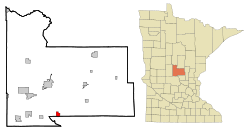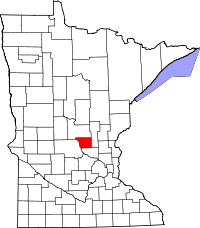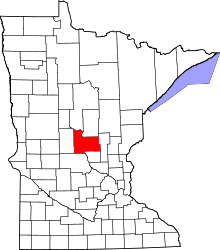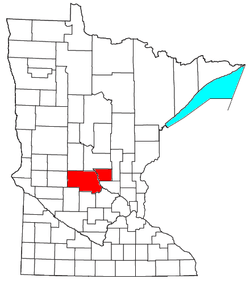Royalton, Minnesota
| Royalton, Minnesota | |
|---|---|
| City | |
 Location of Royalton within Morrison and Benton Counties in the state of Minnesota | |
| Coordinates: 45°50′N 94°18′W / 45.833°N 94.300°W | |
| Country | United States |
| State | Minnesota |
| Counties | Morrison, Benton |
| Area[1] | |
| • Total | 1.99 sq mi (5.15 km2) |
| • Land | 1.99 sq mi (5.15 km2) |
| • Water | 0 sq mi (0 km2) |
| Elevation | 1,079 ft (329 m) |
| Population (2010)[2] | |
| • Total | 1,242 |
| • Estimate (2012[3]) | 1,226 |
| • Density | 624.1/sq mi (241.0/km2) |
| Time zone | Central (CST) (UTC-6) |
| • Summer (DST) | CDT (UTC-5) |
| ZIP code | 56373 |
| Area code(s) | 320 |
| FIPS code | 27-56176[4] |
| GNIS feature ID | 0650375[5] |
Royalton is a city in Morrison and Benton counties in the U.S. state of Minnesota, along the Platte River. The population was 1,242 at the 2010 census.[6] The city is located mainly in Morrison County.
The Benton County portion of Royalton is part of the St. Cloud Metropolitan Statistical Area.
History
Royalton was platted in 1878, and named after Royalton, Vermont, the native home of a share of the early settlers.[7] Royalton was incorporated in 1887.[7]
Royalton has been a participant with Green Step Cities since its inception in 2010 and became the first municipal building in Minnesota to install solar PV pannels with a 7 kW array on the roof of City Hall.[8]
Geography
According to the United States Census Bureau, the city has a total area of 1.99 square miles (5.15 km2), all of it land.[1]
U.S. Highway 10 serves as a main route in the community.
Demographics
| Historical population | |||
|---|---|---|---|
| Census | Pop. | %± | |
| 1890 | 582 | — | |
| 1900 | 664 | 14.1% | |
| 1910 | 676 | 1.8% | |
| 1920 | 690 | 2.1% | |
| 1930 | 518 | −24.9% | |
| 1940 | 518 | 0.0% | |
| 1950 | 500 | −3.5% | |
| 1960 | 580 | 16.0% | |
| 1970 | 534 | −7.9% | |
| 1980 | 660 | 23.6% | |
| 1990 | 802 | 21.5% | |
| 2000 | 816 | 1.7% | |
| 2010 | 1,242 | 52.2% | |
| Est. 2015 | 1,215 | [9] | −2.2% |
| U.S. Decennial Census | |||
2010 census
As of the census[2] of 2010, there were 1,242 people, 455 households, and 324 families residing in the city. The population density was 624.1 inhabitants per square mile (241.0/km2). There were 487 housing units at an average density of 244.7 per square mile (94.5/km2). The racial makeup of the city was 99.0% White, 0.4% Asian, and 0.6% from two or more races. Hispanic or Latino of any race were 0.9% of the population.
There were 455 households of which 42.9% had children under the age of 18 living with them, 56.7% were married couples living together, 8.6% had a female householder with no husband present, 5.9% had a male householder with no wife present, and 28.8% were non-families. 23.3% of all households were made up of individuals and 7.7% had someone living alone who was 65 years of age or older. The average household size was 2.70 and the average family size was 3.18.
The median age in the city was 30.6 years. 31.6% of residents were under the age of 18; 7.9% were between the ages of 18 and 24; 30.1% were from 25 to 44; 20.8% were from 45 to 64; and 9.4% were 65 years of age or older. The gender makeup of the city was 50.1% male and 49.9% female.
2000 census
As of the census[4] of 2000, there were 816 people, 322 households, and 209 families residing in the city. The population density was 473.7 people per square mile (183.2/km²). There were 328 housing units at an average density of 190.4 per square mile (73.6/km²). The racial makeup of the city was 98.77% White, 0.25% Native American, 0.49% Pacific Islander, and 0.49% from two or more races. Hispanic or Latino of any race were 0.86% of the population.
There were 322 households out of which 34.8% had children under the age of 18 living with them, 51.2% were married couples living together, 8.7% had a female householder with no husband present, and 34.8% were non-families. 27.0% of all households were made up of individuals and 13.7% had someone living alone who was 65 years of age or older. The average household size was 2.53 and the average family size was 3.14.
In the city the population was spread out with 26.8% under the age of 18, 10.8% from 18 to 24, 30.9% from 25 to 44, 17.9% from 45 to 64, and 13.6% who were 65 years of age or older. The median age was 34 years. For every 100 females there were 101.5 males. For every 100 females age 18 and over, there were 94.5 males.
The median income for a household in the city was $33,173, and the median income for a family was $42,188. Males had a median income of $31,167 versus $20,446 for females. The per capita income for the city was $15,926. About 6.3% of families and 9.0% of the population were below the poverty line, including 8.4% of those under age 18 and 15.9% of those age 65 or over.
Education
The Royalton school district operates one elementary school and one high school. As with other Minnesota school districts, Royalton schools offer open enrollment. The athletic team's moniker for the high school is the Royals with the Mascot being a Lion. Royalton offers sports through both schools and extra activities. In elementary school, there is the disadvantage of not playing other teams in sports.
Royalton Elementary School is located next to Holy Trinity Church. Catholic children may go to religion classes during the day when scheduled (normally Wednesdays before lunch). With app. 2 teachers per grade and 30 students in each class, it is a moderately small-sized school.
Royalton offers "M.A.P." (My Afterschool Place) to children who are not picked up right away after school.
Notable people
The DeZurik Sisters, a singing act
Jim Langer, NFL Hall of Fame Football player 1970-1981
References
- 1 2 "US Gazetteer files 2010". United States Census Bureau. Archived from the original on 2012-01-24. Retrieved 2012-11-13.
- 1 2 "American FactFinder". United States Census Bureau. Retrieved 2012-11-13.
- ↑ "Population Estimates". United States Census Bureau. Archived from the original on 2013-06-17. Retrieved 2013-05-28.
- 1 2 "American FactFinder". United States Census Bureau. Archived from the original on 2013-09-11. Retrieved 2008-01-31.
- ↑ "US Board on Geographic Names". United States Geological Survey. 2007-10-25. Retrieved 2008-01-31.
- ↑ "2010 Census Redistricting Data (Public Law 94-171) Summary File". American FactFinder. U.S. Census Bureau, 2010 Census. Archived from the original on 21 July 2011. Retrieved 23 April 2011.
- 1 2 Upham, Warren (1920). Minnesota Geographic Names: Their Origin and Historic Significance. Minnesota Historical Society. p. 355.
- ↑ "Royalton, MN website - Green Step Cities". Retrieved 2016-8-23. Check date values in:
|access-date=(help) - ↑ "Annual Estimates of the Resident Population for Incorporated Places: April 1, 2010 to July 1, 2015". Retrieved July 2, 2016.
External links
Coordinates: 45°50′N 94°18′W / 45.833°N 94.300°W


